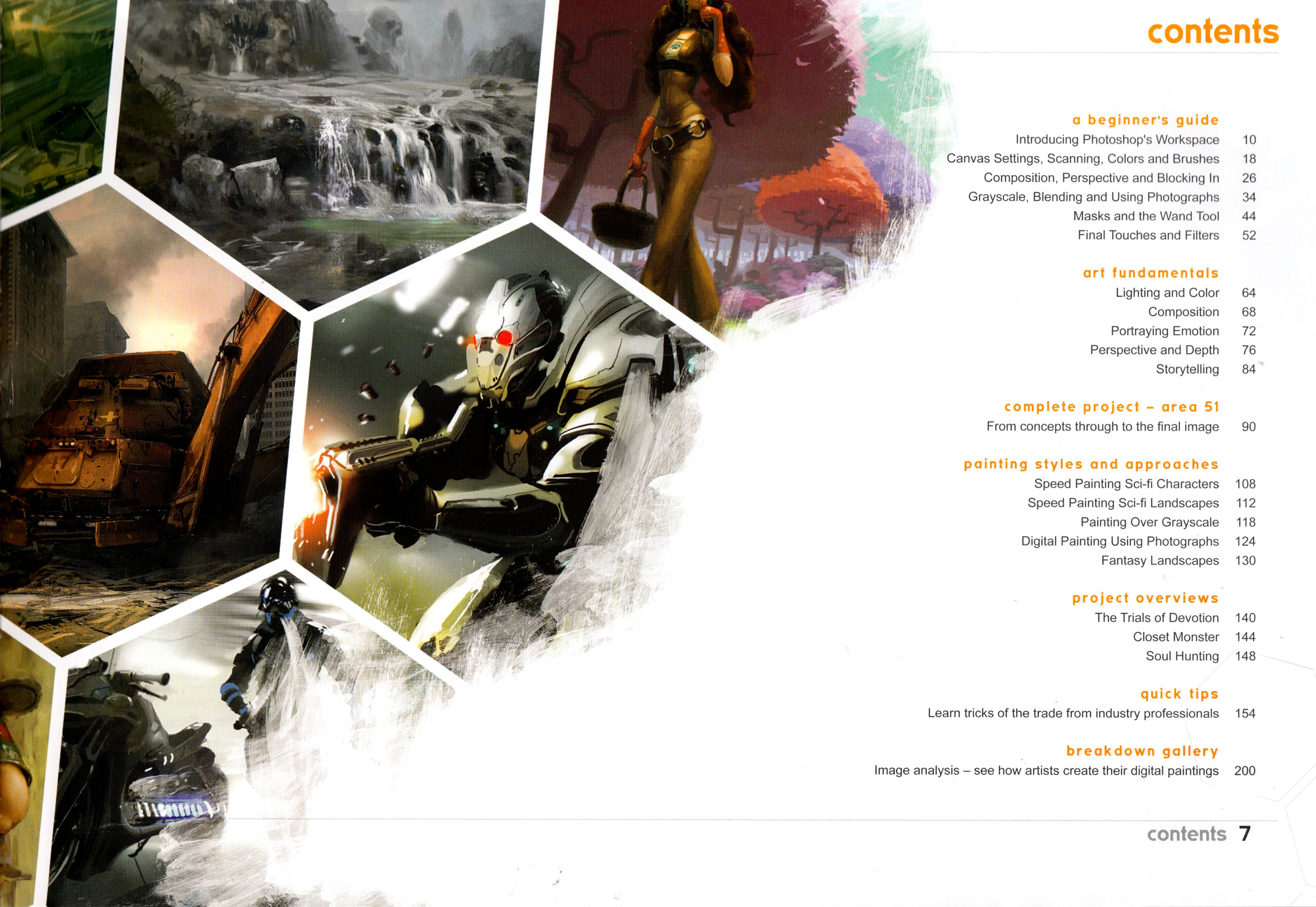Beginner's Guide to Digital Painting in Photoshop by Nykolai Aleksander and Richard Tilbury

Beginner's Guide to Digital Painting in Photoshop by Nykolai Aleksander and Richard Tilbury (3DTotal Publishing, 2012)
The next entry to Reading section’s series dedicated to creating digital art is a comprehensive guide to the basics of digital painting in Photoshop. The authors of this handbook are professional artists with years of experience in digital painting who offer up “a wealth of suggestions and advice to get you started, improve workflows, perfect techniques, and produce stunning images.”
Excerpts from the Introduction
“The same skill set and eye for design is required when working in Photoshop as it would be when painting traditionally in oils. So what are the benefits of working digitally then? Well the truth is you won’t really know the answer to that until you try digital painting for yourself. The major advantages include speed, tidiness and ease, but to just list these would be selling Photoshop short. Imagine being able to make large adjustments to the color of your paintings by moving sliders, and being able to use custom brushes with set designs and patterns to create unique and interesting textures over large areas of your image. The possibilities really are endless.”
Book description
“We’ll be going through setting up Photoshop and a graphics tablet, learning about brushes, sketching, colors, composition, perspective, layers, textures, lighting, different tools and filters. Keep in mind that this is more of a technical look at things, and will not be dealing with how to paint one thing or another, although I will brush over things occasionally.”

The book is split into several main chapters, which, in turn, are divided into smaller sections.
The first chapter, called “A Beginner’s Guide”, covers the setting up of Photoshop and a Wacom tablet, and understanding the interface with regards to digital painting and one’s artistic needs. It introduces the workspace of Photoshop (canvas settings, colors, brushes etc.), as well as some tools, such as masks and texture brushes, and certain adjustment techniques through a particular painting.
With the second chapter, “Art Fundamentals”, the book dives into more artistic territory, considering composition, perspective and depth, lighting and color variations, with the emphasis on what makes a painting good or great.
The next chapter puts into practice some of the tools and techniques discussed earlier in the book by creating a finished painting step-by-step, from planning and sketching, through detailing, to finally texturing (“Complete Project”).
The rest of the book deals with painting styles and approaches to creating concept art, especially painting fantasy and sci-fi imagery, a theme on which the book focuses on.
In “Project Overviews”, three artists explain step-by-step the creation of one of their artworks respectively.
The “Quick Tips” chapter at the end offers, as its name suggests, useful tips for creating specific tricky effects and textures, such as clouds, water, trees, rain, fire, smoke, different fabrics, glow etc., which help make a painting come alive.
And finally, there is an image gallery at the end, where artists show the creation of an artwork in five pictures, without any explanatory text (“Breakdown Gallery”).
Sample pages





What we like
- Photoshop has almost infinite potential in terms of creating artwork, being it epigraphic documentation or SFF concept artistry – if one knows how to use it! This book aims to help those interested in making the transition over to digital painting by showing how to replicate traditional techniques digitally.
- Despite its title, this book is not (only) intended for absolute beginners who are just learning about digital painting in Photoshop. Instead, it offers techniques valuable even for professional artists with a good command of this software.
- Beginner’s Guide differs somewhat in style from other similarly titled handbooks, as it offers more in-depth written information on certain topics as opposed to image-based step-by-step tutorials. This allows the readers to use the acquired knowledge in their own way and create their own art, instead of merely copying an example-sequence.
- Many sections include links to accompanying resources for the tutorials, which can be downloaded from the 3dtotalpublishing.com website.
- The style of the book is clear and well-arranged, the writing is matter-of-fact yet accessible, and it’s not overcrowded by images and colorful graphics. Don’t be put off by the sci-fi and fantasy imagery, the tips and advises can be used in a wide range of projects!
Additional reading
“Beginner's Guide to Digital Painting in Photoshop” is available for purchase at amazon.com, amazon.co.uk and amazon.de, as well as bookdepository.com, among other retailers.
At the publisher’s website, 3dtotal.com, you will find additional resources of all levels, including step-by-step tutorials on digital painting.
You can read digitalEPIGRAPHY’s previous articles dedicated to creating digital art here and here.
Précis and commentary by Júlia Schmied




0 comment(s)
Leave a comment(We'll keep your email address private)